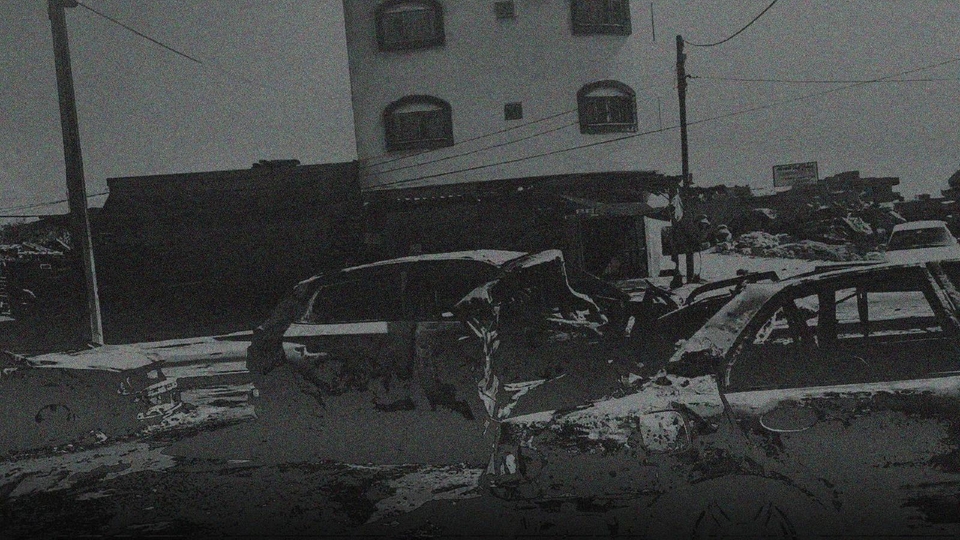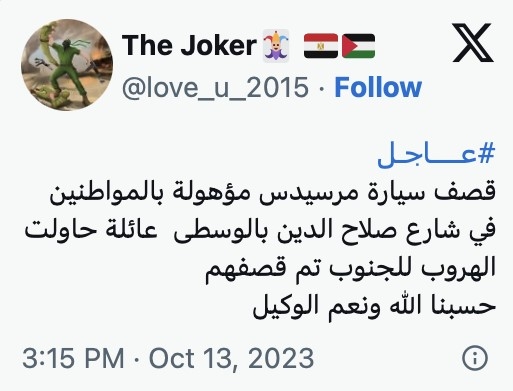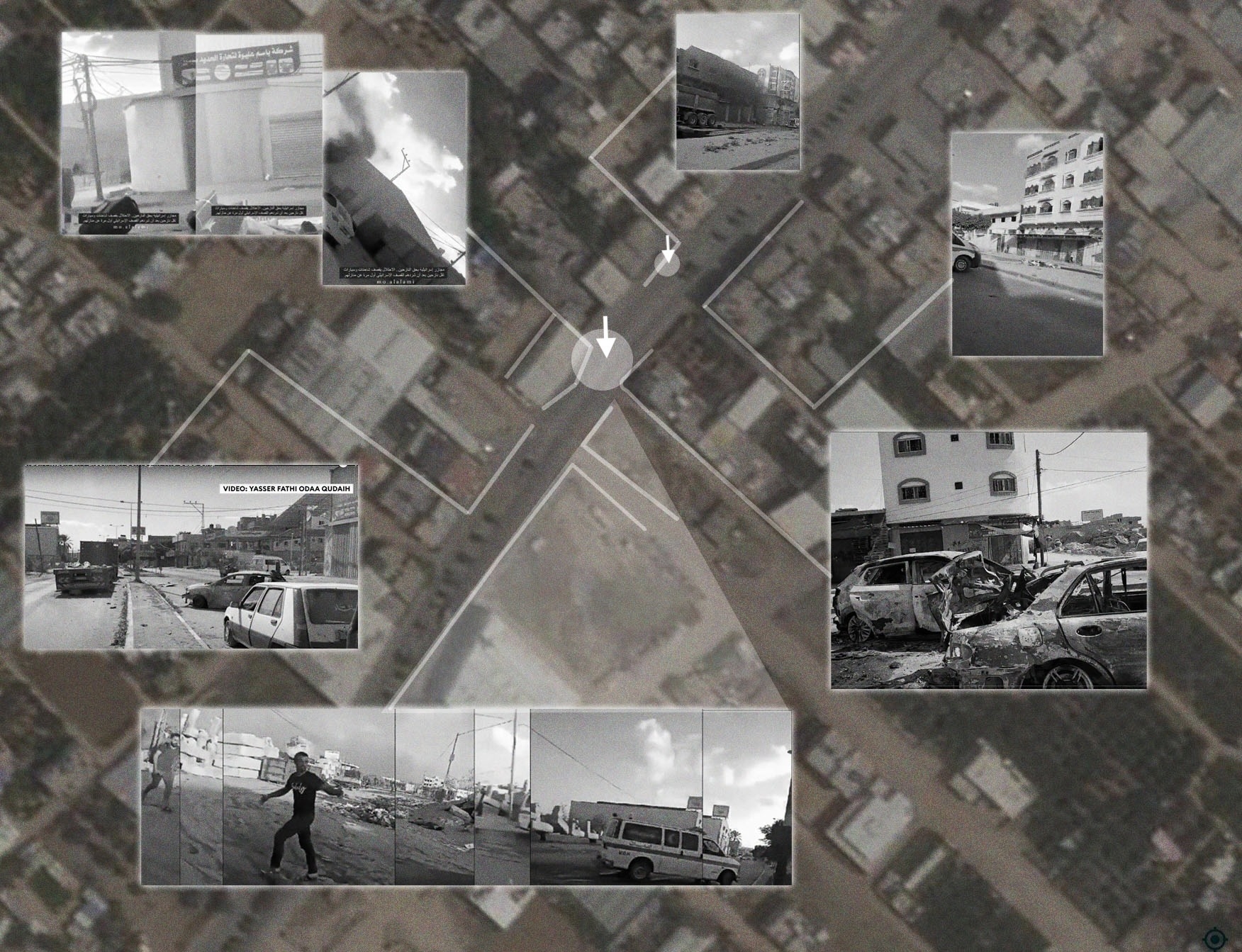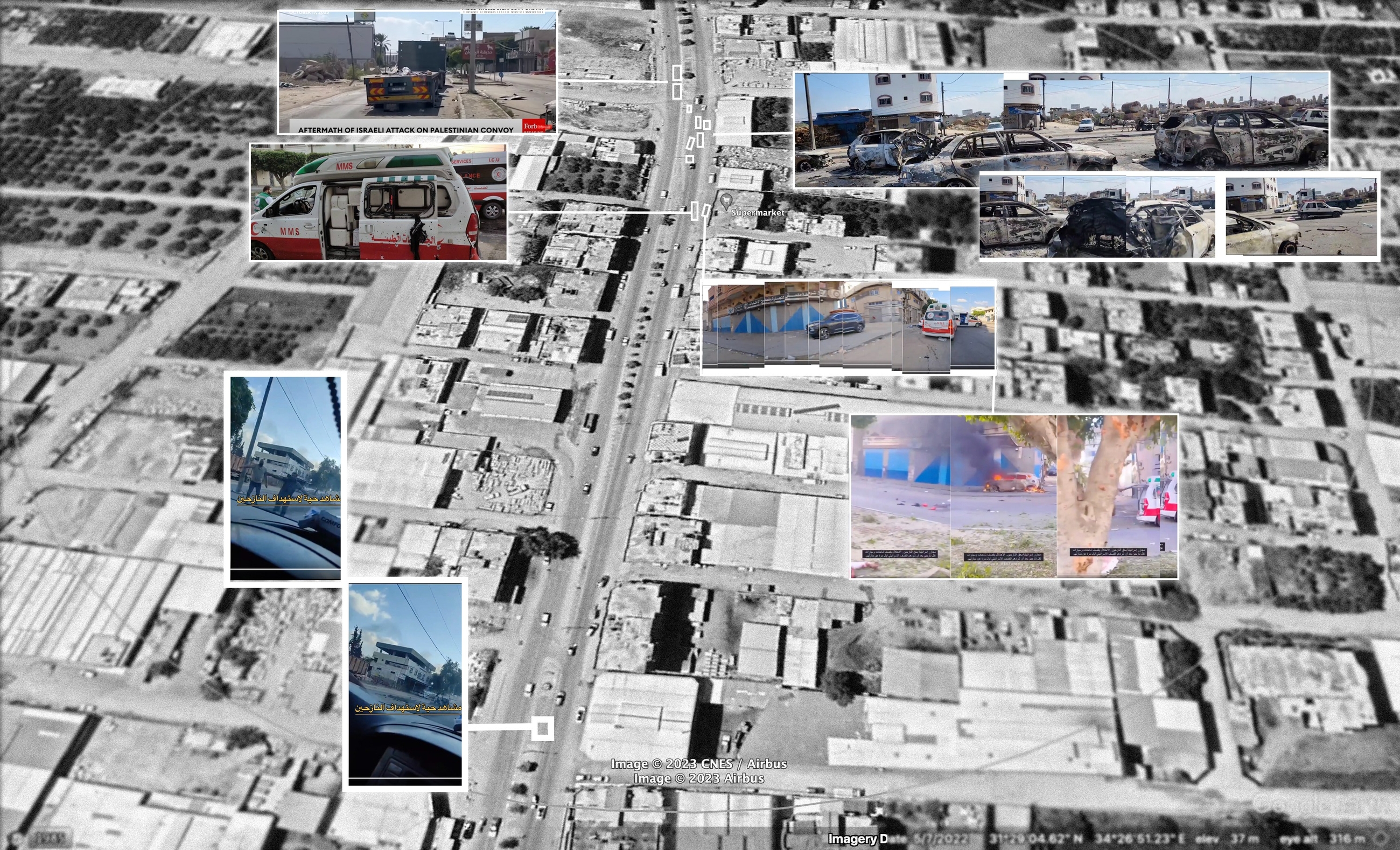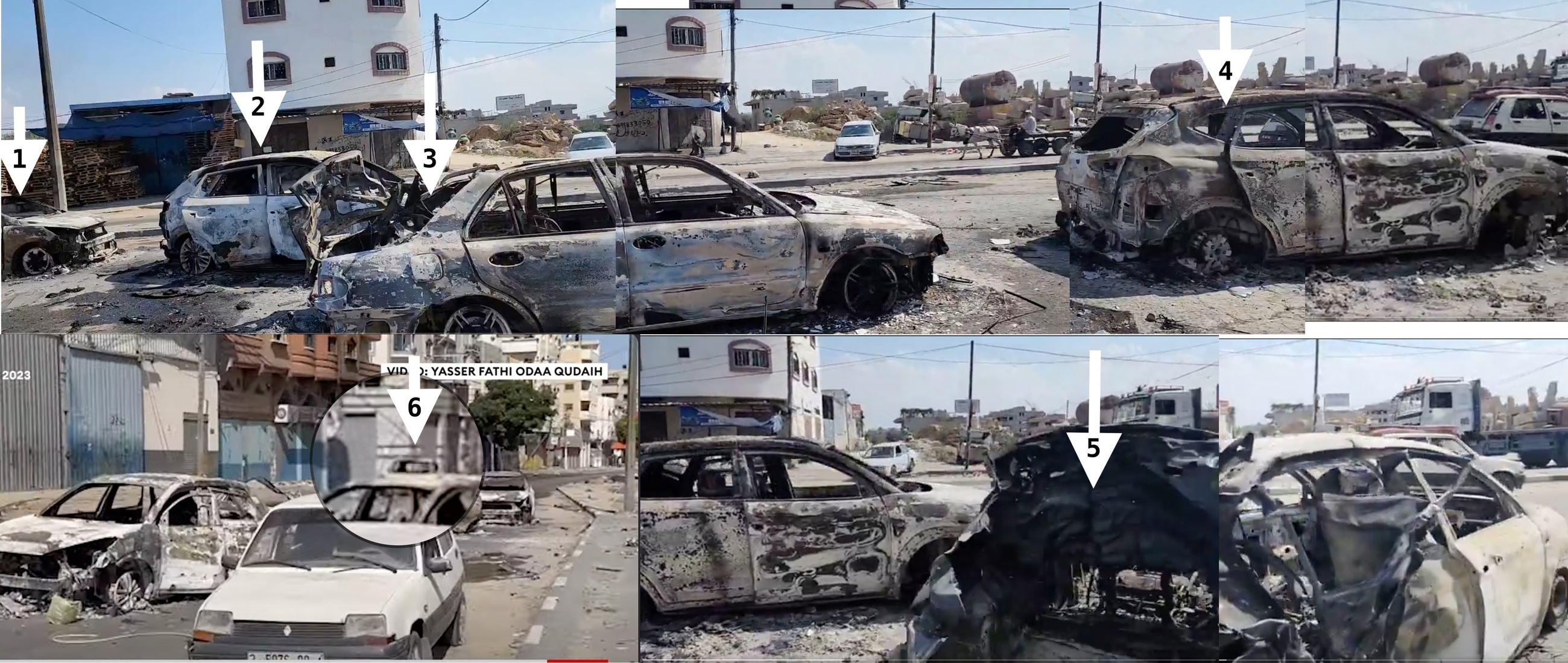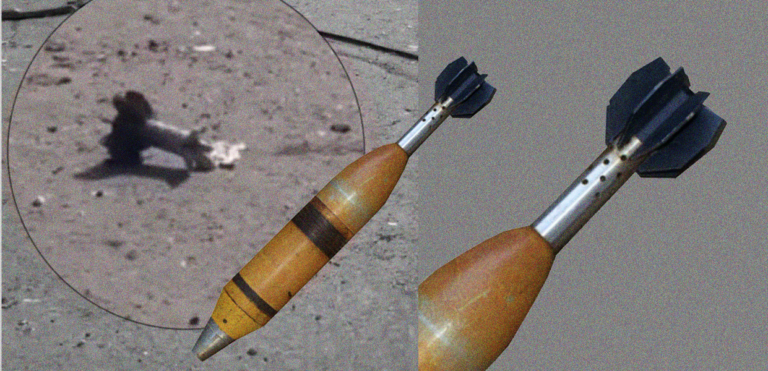Salah al-Din Street: Israeli Airstrikes on Convoy of Displaced People
Editor's Note: This is one of several open-source intelligence (OSINT) investigations conducted by the NAWA Media Open-Source Investigations Team in collaboration with journalists at The Public Source. These reports were produced in October and November of last year; due to the rapidly escalating violence, the figures are a historical record of that time rather than a reflection of the current reality. Through these reports, we aim to contribute to the growing body of evidence of war crimes and crimes against humanity committed by Israel in its war against the Palestinian people in Gaza. For this reason, the authors of these investigations use precise and cautious language that helps in advancing the prosecution of these crimes in international courts.
Photos and videos published on social media and news websites on the day of the attack and the following three days were collected, preserved, and analyzed. Thirty two different media sources were used in the investigation.
The date and time of the attack were determined using X’s (formerly Twitter) advanced search and InVID, an open-source tool that extracts media date and time through video fragmentation and reverse image search. We used these data to confirm the local time of the first post about the attack. SunCalc, an open-source tool that determines the time photos and videos were taken based on the length and direction of shadows, was also used to determine the time of images taken at the attack site. Results from SunCalc were consistent with the results of the first post published on X.
We matched photos and videos published by users on social media showing a truck with two trailers impacted by the attack, a number of bodies dumped at the site of the attack, a damaged ambulance on the side of the road on Salah al-Din Street, and several cars that appeared to be burning.
The geographical location on Salah al-Din Street was determined by searching for Salah al-Din Street, Street No. 10, and Gaza Valley Bridge on OpenStreetMap which contains more accurate data of the names of local areas than Google Maps and Google Earth. We then specified a search range of 4.6 km around the area of attack, pinpointed distinctive visual identifiers such as shops that appeared in the photos and videos, and compared them to satellite images.
We determined who is likely responsible for the attack based on an analysis of the trajectory of the munition and their penetration angles in the cars. We used the location of the damage and evidence of its impact, the location of the cars in Salah al-Din Street near the Kuwait Roundabout, and information on who was in control of the area.
This investigation is the result of multiple stages of analysis of available open-source information of the date, time, and location of the incident, as well as information on the munitions allegedly used and the party allegedly responsible for the attacks and the resulting damage. Through examining all available information about the attacks, this investigation provides an understanding of the incident as well as the alleged perpetrators.
The Gaza Strip has been subject to horrific attacks by the Israeli occupation forces since early October 2023, resulting in massive human losses, unprecedented destruction of infrastructure, and the eradication of entire populated residential areas.
Even convoys of displaced people were not spared in these attacks, as one such convoy was subjected to multiple attacks along Salah al-Din Street near the Kuwait Roundabout on the afternoon of Friday, October 13, 2023, during its passengers' evacuation towards the south of the Strip under Israeli military orders. At least three of these attacks directly hit cars carrying displaced people along the road. Shrapnel also hit a truck with two trailers carrying displaced people. The attacks killed 70 people and injured more than 200 others. The Israeli military, through its official spokesperson, presented a misleading narrative in an attempt to shift responsibility for the attack away from Israel, and used a video clip of another incident at a different location and time to deny responsibility for the attack.
The video presented by the Israeli military spokesperson shows an explosion filmed on Wadi Gaza Bridge, about 4 kilometres away from the site of the Salah al-Din Street attack. By analyzing shadows in the clip, it appears the video was taken at 14:59 local time in Gaza City, while the series of Salah al-Din Street attacks took place between 15:15 and 17:20, meaning the latter started 16 minutes later than the Wadi Gaza attack.
By examining the data we have about the two attacks, it can be confirmed that the Wadi Gaza Bridge incident is completely different from the multiple attacks that targeted a convoy of displaced people on Salah al-Din Street near the Kuwait Roundabout. The widespread use of the video out of context by media outlets and fact-checking platforms led to misinterpretations about the nature of the two incidents. As a result, the Israeli military spokesperson used these analyses to deny Israel’s responsibility for the attack.
The NAWA Media Open-Source Investigations Team monitored and analyzed open-source content of the attacks on the convoy on October 13. We also analyzed the events and contexts of relevant visual materials to put together this investigation, which aims to uncover the circumstances of the attack and to try to determine the party responsible for it.
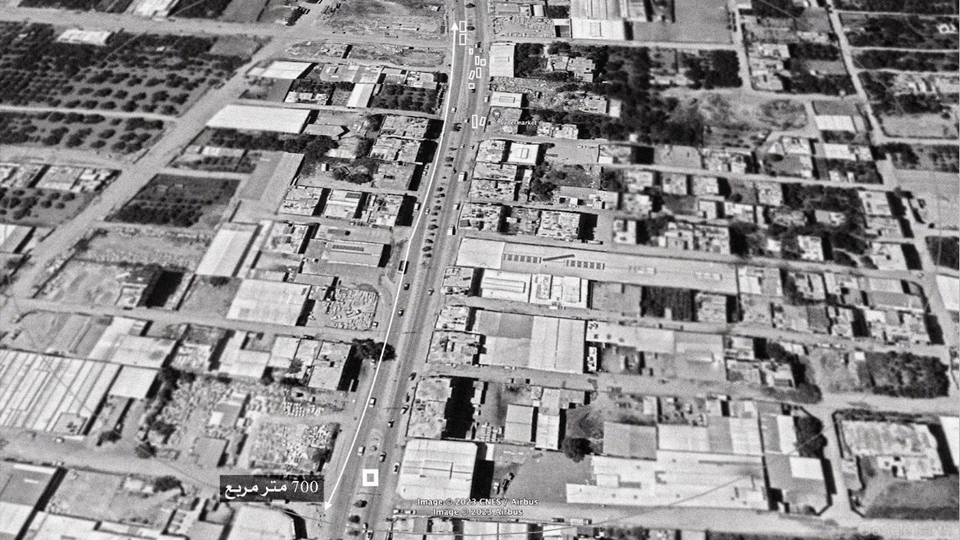
A screenshot of a satellite image from Google Earth Pro of “the subject of investigation” Salah al-Din Street, which was impacted by several attacks that hit a convoy of displaced people.
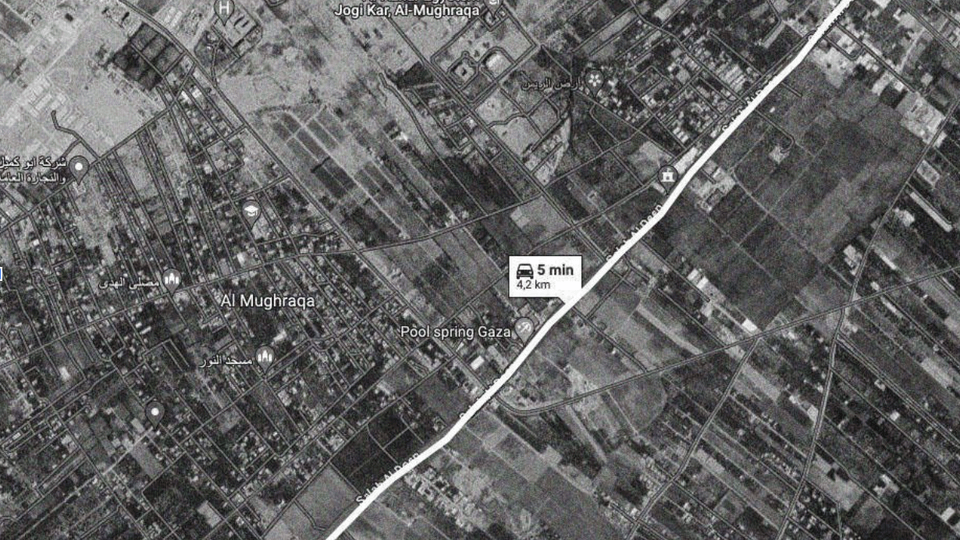
A screenshot of a satellite image from Google Maps showing the distance between the site of the Wadi Gaza Bridge incident and the site of the Salah al-Din Street attacks, the Kuwait Roundabout.
Evacuation Order
On the morning of October 13, 2023, the Israeli military published a warning to residents of northern Gaza on X (formerly Twitter). In the social media post, the military was calling for the evacuation of all civilians from their homes in Gaza City southwards for "their own safety and protection," and had ordered the civilians to move to the area south of Wadi Gaza.
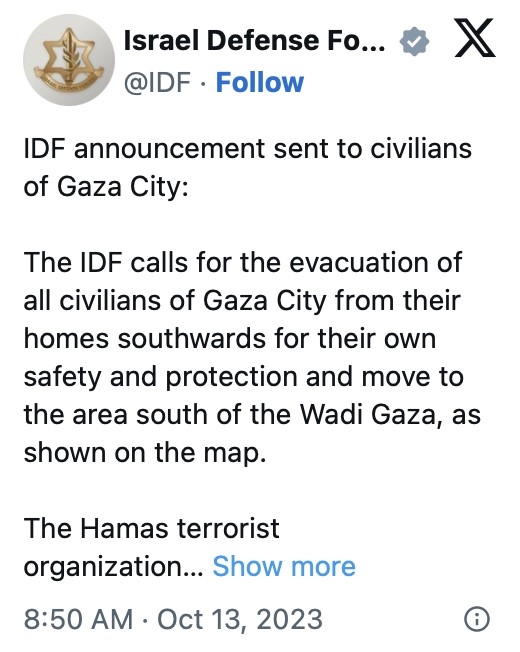
A screenshot of the Israeli military announcement on October 13, 2023, at 8:50 a.m.
The Israeli military’s official spokesperson, Avichai Adraee, also shared an update to the evacuation announcement on his Facebook page the same evening of October 13, 2023, adding: “We appealed to you in the morning to leave Gaza City to the area south of the Gaza Valley, for your safety. I would like to inform you that the IDF will refrain from touching the route marked on the map until 20:00.” This was the only announcement online that provided information about the designated displacement route.
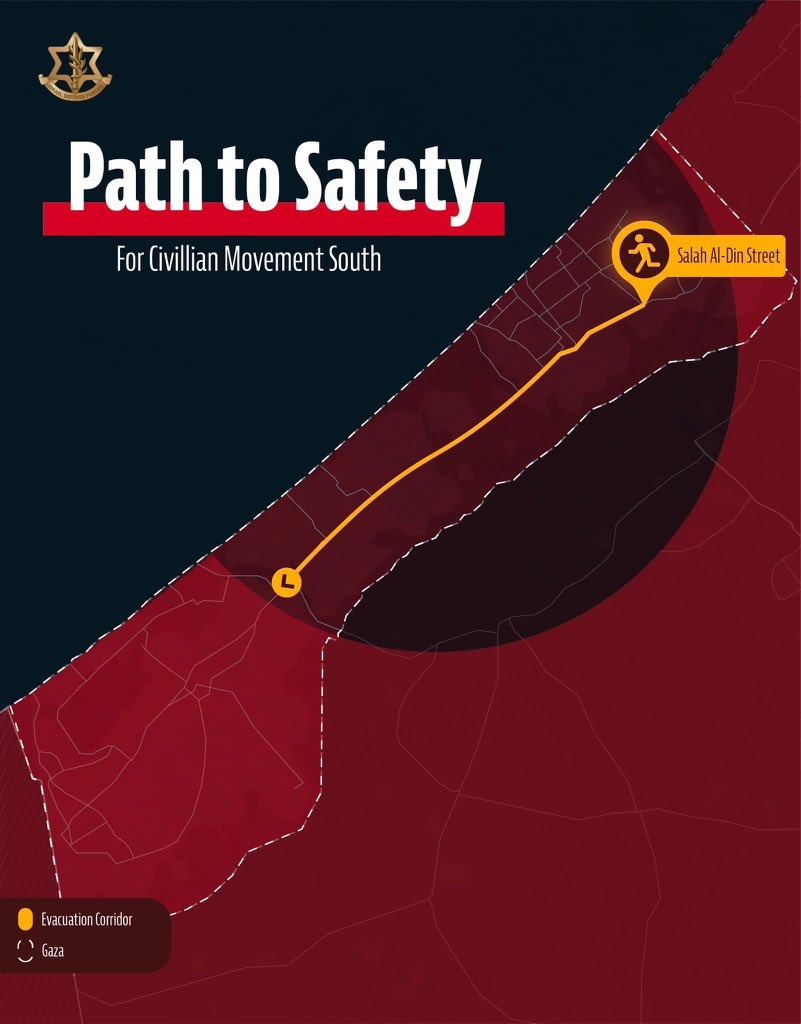
Adraee’s post explaining that Salah al-Din Street is a safe route for evacuation from the north to the south of Wadi Gaza, from the morning until 20:00.
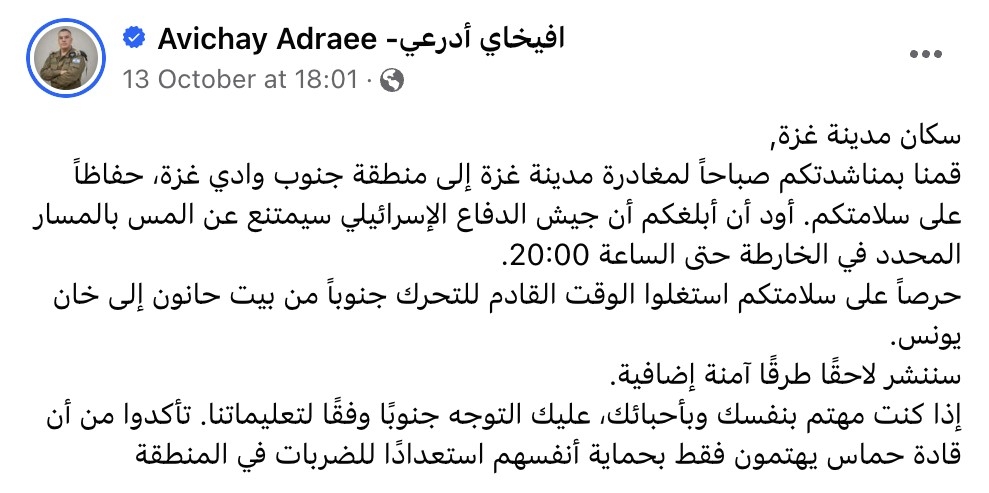
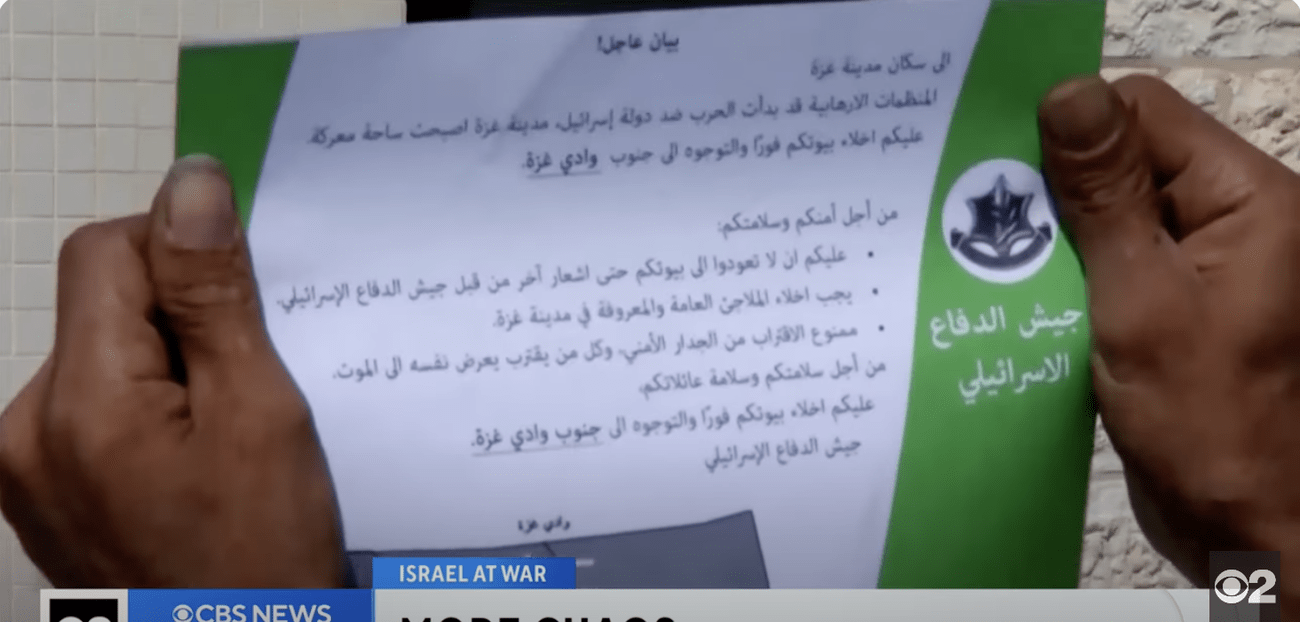
An image from a CBS Chicago video of one of the leaflets dropped by Israeli planes over Gaza on October 13.
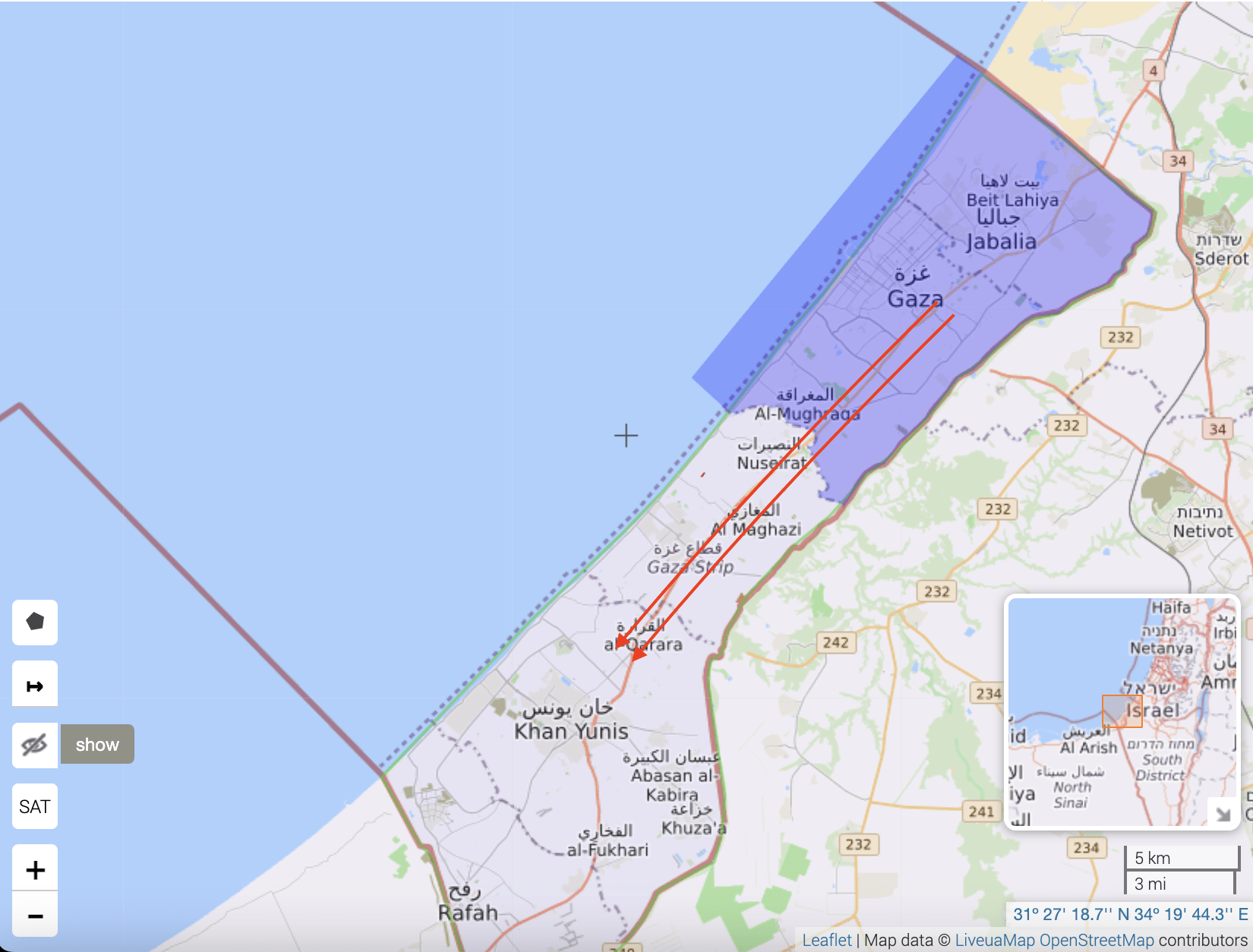
A screenshot of a Liveuamap map of Gaza City. Blue: Civilian evacuation zone from northern Gaza. Red arrows: The direction of the evacuation towards the south; civilians were instructed to move south. Screenshot taken in October 2023.
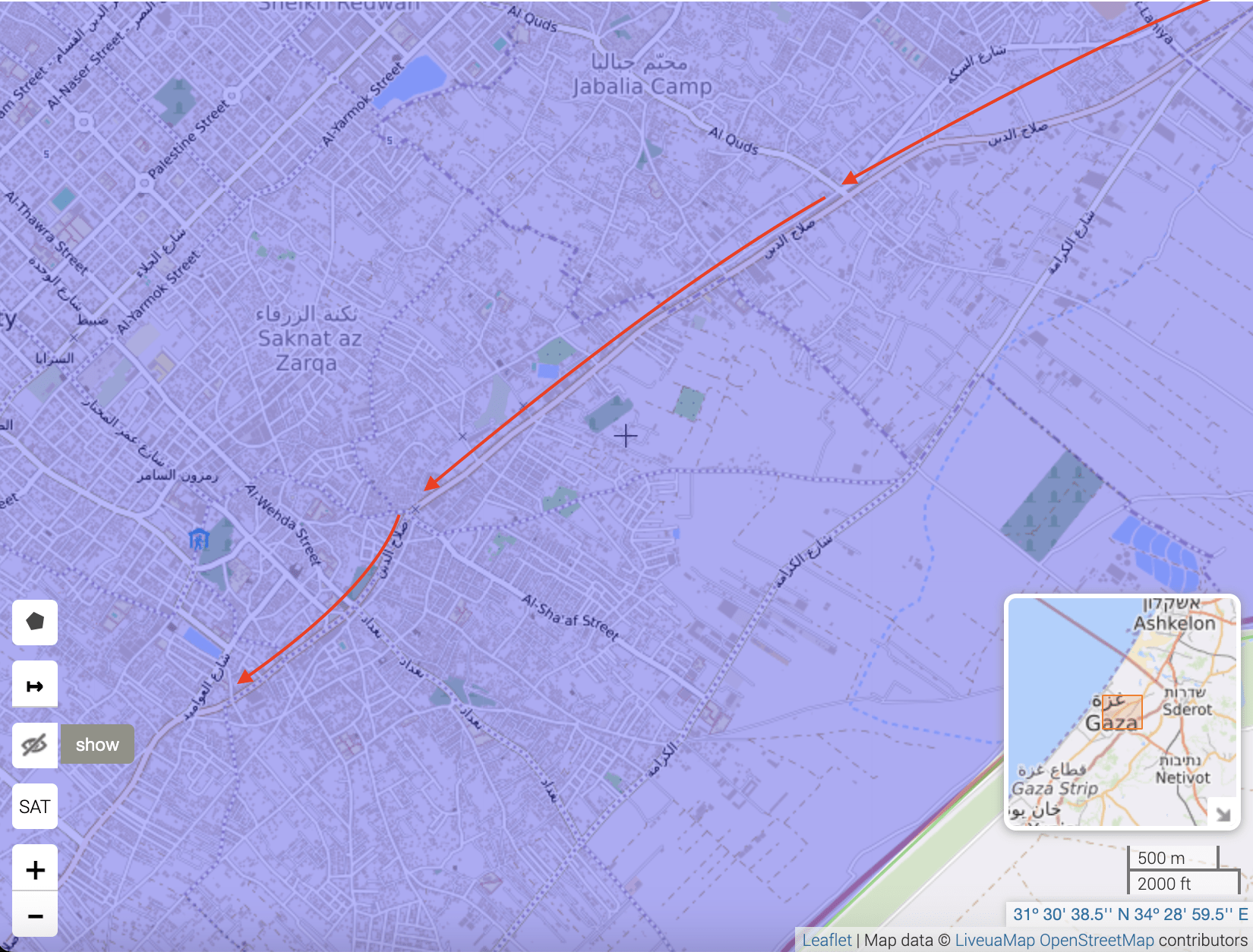
A screenshot of a Liveuamap map of Gaza City showing part of Salah al-Din Street. Blue: Civilian evacuation zone from northern Gaza. Red arrows: Direction of civilian movement towards the south via Salah al-Din Street. Screenshot taken in October 2023.
What Happened?
On October 13, 2023, an X user named The Joker posted at 15:15 local time in Gaza about the bombing of a Mercedes car full of civilians on Salah al-Din Street in the center of the Gaza Strip, after they tried to leave and head south. Tariq Mesleh’s Facebook account also posted at 16:32 local time in Gaza: “Cars were bombed near the car market on Salah al-Din Street... People were displaced and they bombed them.” Additionally, an X account with the handle @NerminHwaihi asked, “What is happening in the Zaytoun neighborhood? News about massacres” at 16:55 local time. According to our analysis, the three accounts were the first to post about the attack.

At 19:00 on the same day, the Palestinian government media office published an official announcement about the Israeli military’s bombing of several cars carrying displaced people towards southern Gaza. A video published by the Palestinian Ministry of Health in Gaza showed an ambulance driver, whom it described as “a witness to a real massacre,” collapsing and kneeling to the ground as he arrived at the hospital, speaking into the camera and saying, “Advise people to go to their homes, they bombed the displaced people who are in trucks,” explaining that displaced people in trucks were bombed. He went on to say, “They told the people to relocate and then bombed them.” Someone next to him added that trucks and ambulances were also bombed.
Geographical Location: Where Did the Attack Take Place?
By analyzing and matching the visual content of videos published by the Palestinian Ministry of Health in Gaza; journalist Ragıp Soylu; Local Focus, and other videos online, it was possible to determine the coordinates of some of the strikes that were clear and documented. An attack on a group of cars behind the two trailers next to Aslim Petrol Station on Salah al-Din Street by the Kuwait Roundabout in Gaza City took place specifically at coordinates 31.483005, 34.444769.
Another attack took place minutes later and a few meters away from the first. It hit a car in front of Daghmush Company for Trading and Tire Repair stores, next to the ambulance crews after they arrived to the location of coordinates 31.483354, 34.445045. It cannot be confirmed whether these were the only two attacks, as the number of attacks may be much higher.
When Did the Attack Happen?
After The Joker posted that a bomb targeted a car on Salah al-Din Street, various websites and accounts published videos of the attack. Based on shadow movement calculated using SunCalc, and the timeline of damage by successive strikes at the site of the attack shown in the videos, we were able to arrange the events and create a possible timeline.
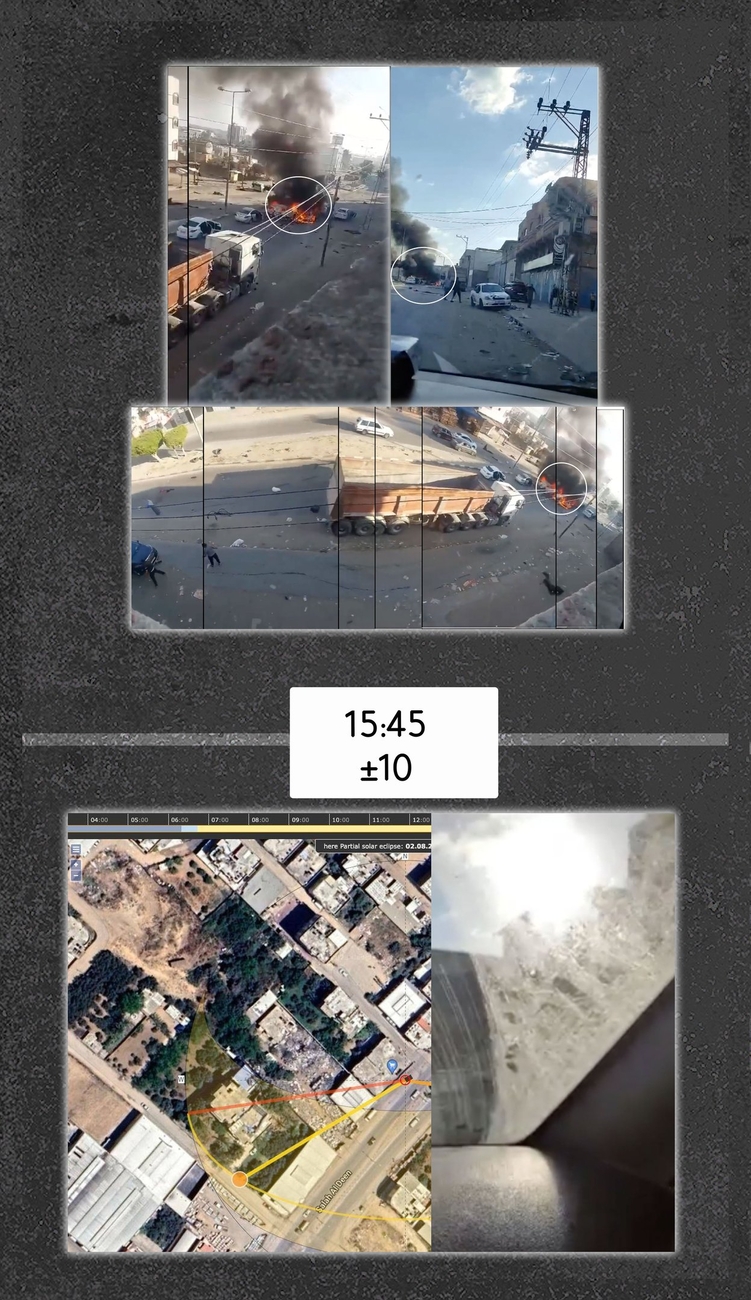
Journalist Khaled Iskif published a video filmed from the top of a building in the area of the attack. The footage shows flames rising from two burning cars, which had two cars next to them, but the extent of the damage is unclear. In comparing this video to a video published by the Palestinian Ministry of Health/Gaza, it appears both videos were filmed at the same time from two different angles. Through analysis of the shadows from one of the clips it appears that the likely time of filming was approximately 15:45 ± 10 minutes local time in Gaza City.
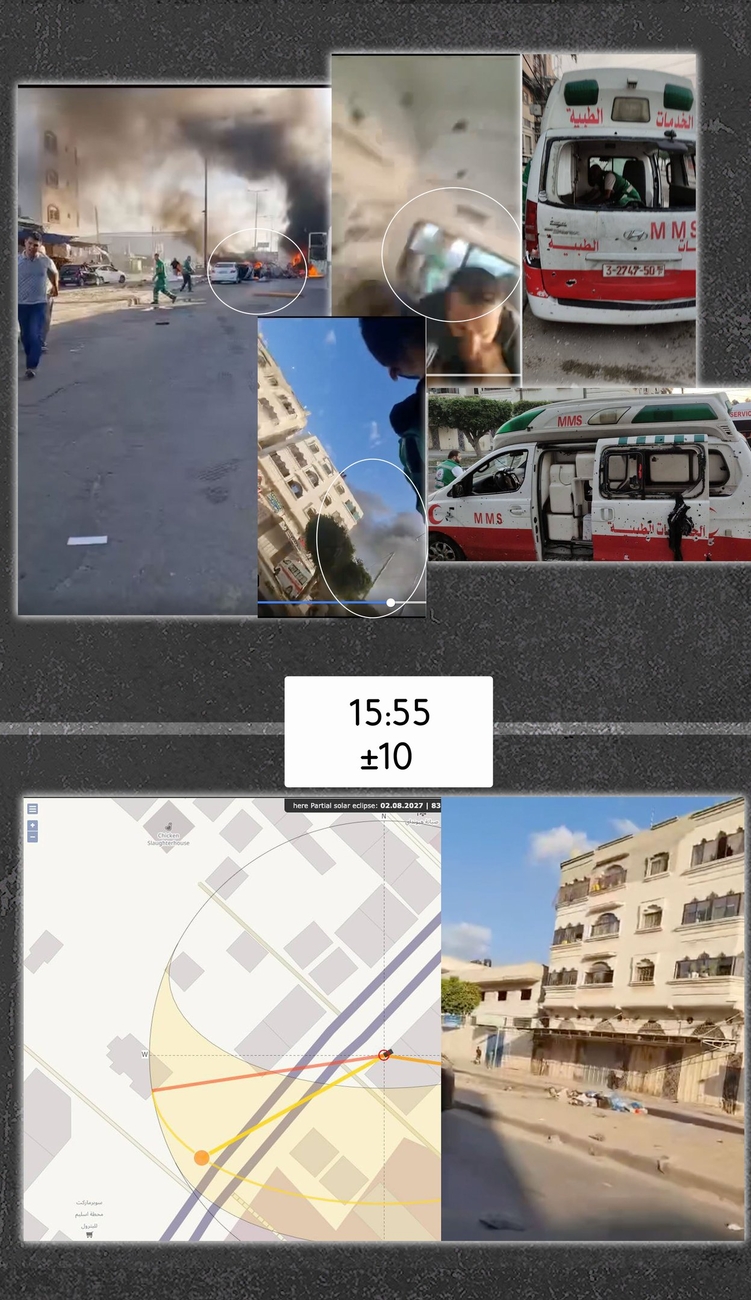
The Palestinian Ministry of Health/Gaza published another video documenting three attacks that happened only seconds apart. One was a direct attack on a car parked to the side of the ambulance. The car was damaged, injuring two ambulance crew members who appeared at the end of the previous video. “I have an injury in my leg,” said one of the ambulance crew members in the video, before pointing the camera to show a colleague’s head injury. By analyzing shadows in one of the shots, we can estimate the time was approximately 15:55 ± 10 minutes local time in Gaza City when the video was filmed. The footage showed what appeared to be the dying down of the fire engulfing one of the two cars found in Iskif’s video, and showed the burning of a new one. This introduces the possibility that an attack occurred between the time Iskif and the Ministry of Health’s videos were taken.
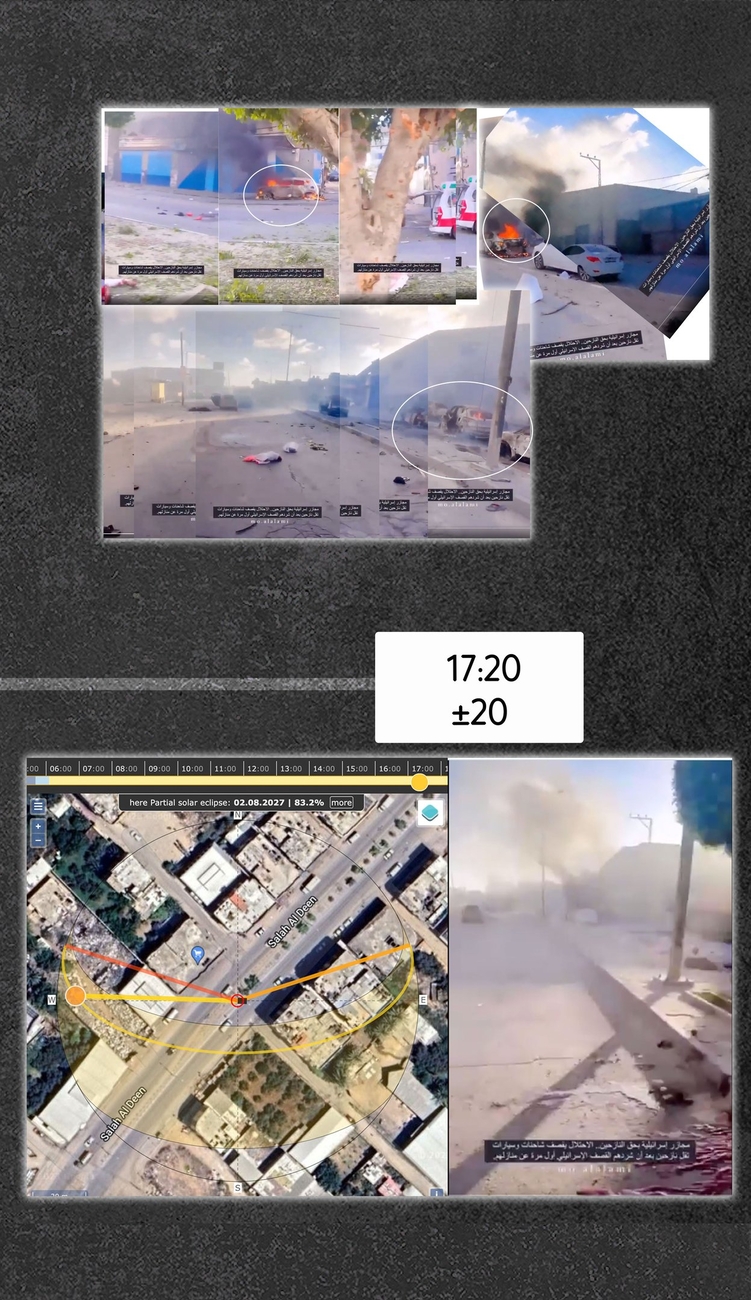
Finally, a video published by Soylu on X appears to have been taken some time after the attack on the ambulance crew: It shows the group of burning cars and also shows the car next to the ambulance burning, but the amount of smoke has decreased, the car’s color has changed, and all of its tires are burnt. A person’s body can be seen lying in the middle of the road, possibly hit by shrapnel from the explosion of the projectile that fell next to the ambulance. By analyzing the shadow of one of the shots in the video, we can estimate the time it was taken to be approximately 17:20 ±20 local time in Gaza City.
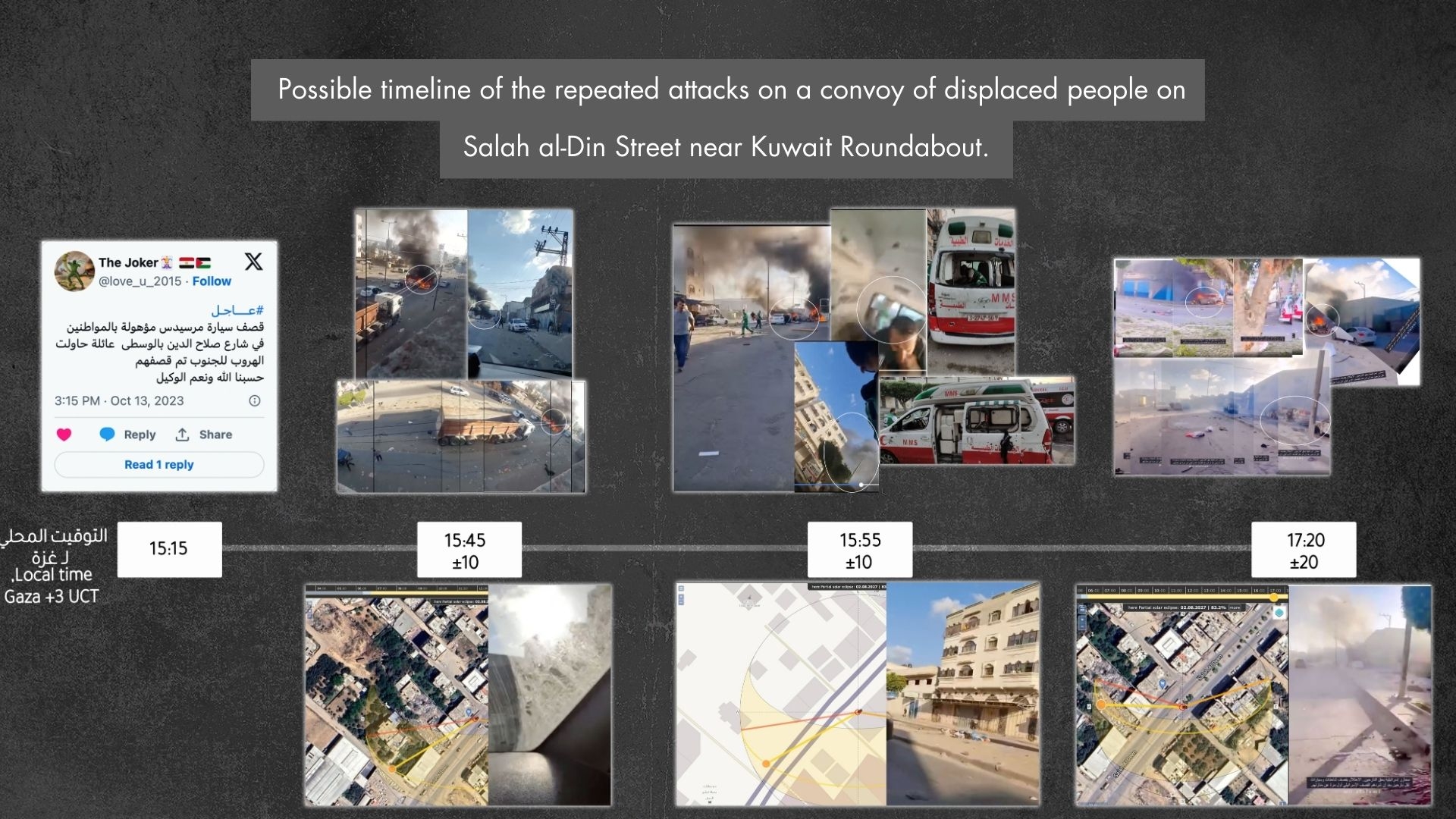
We cannot confirm the time estimates that we arrived at through shadow analysis, as the images of the shadows were taken from imprecise locations and analysis the provided different results. However, we can conclude that the likely time of the multiple attacks on the convoy of displaced people on Salah al-Din Street near Kuwait Roundabout was between 15:15 and 17:20 Gaza City time. One of these attacks included three strikes only seconds apart.
Impact of the Attack
Considering the timeline and videos of the attack, we hypothesize that the shelling was not precisely targeted1 and instead proceeded indiscriminately along the impacted Salah al-Din Street, as most attacks were within a distance of about 700 square meters.
- 1International law considers a bombardment indiscriminate if it “treats as a single military objective a number of clearly separated and distinct military objectives located in a city, town, village or other area containing a similar concentration of civilians or civilian objects” (API Art. 51.5.a).
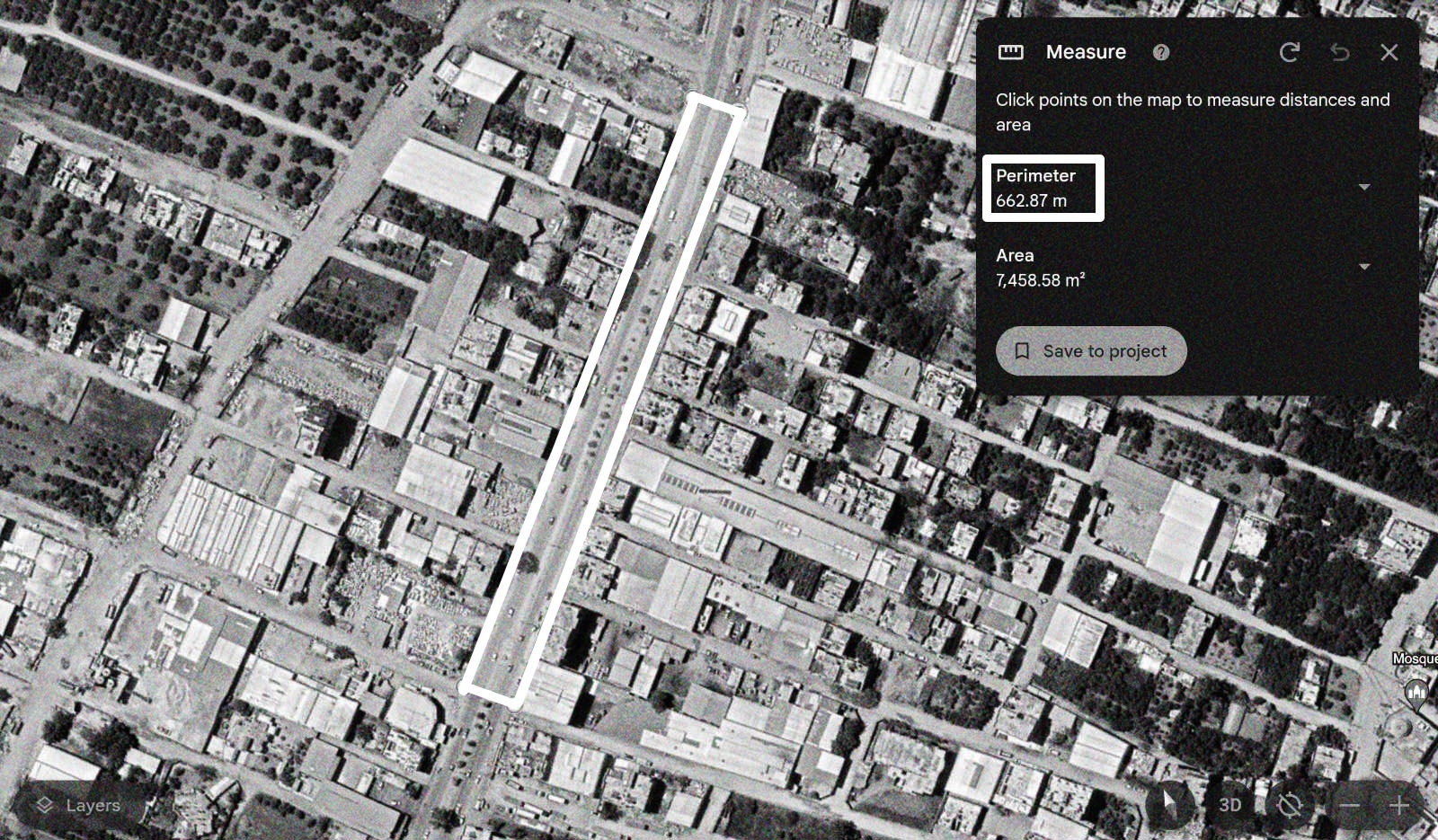
The bombing burned and destroyed six passenger cars. Several other cars parked nearby were damaged, in addition to the ambulance that was damaged by shrapnel from the projectile that fell next to it. The bodies of seven civilians can be seen scattered along the street. Seventy people were killed and more than 200 wounded in the attack, according to Al Jazeera citing the Palestinian Ministry of Health. The Ministry did not publish their names.
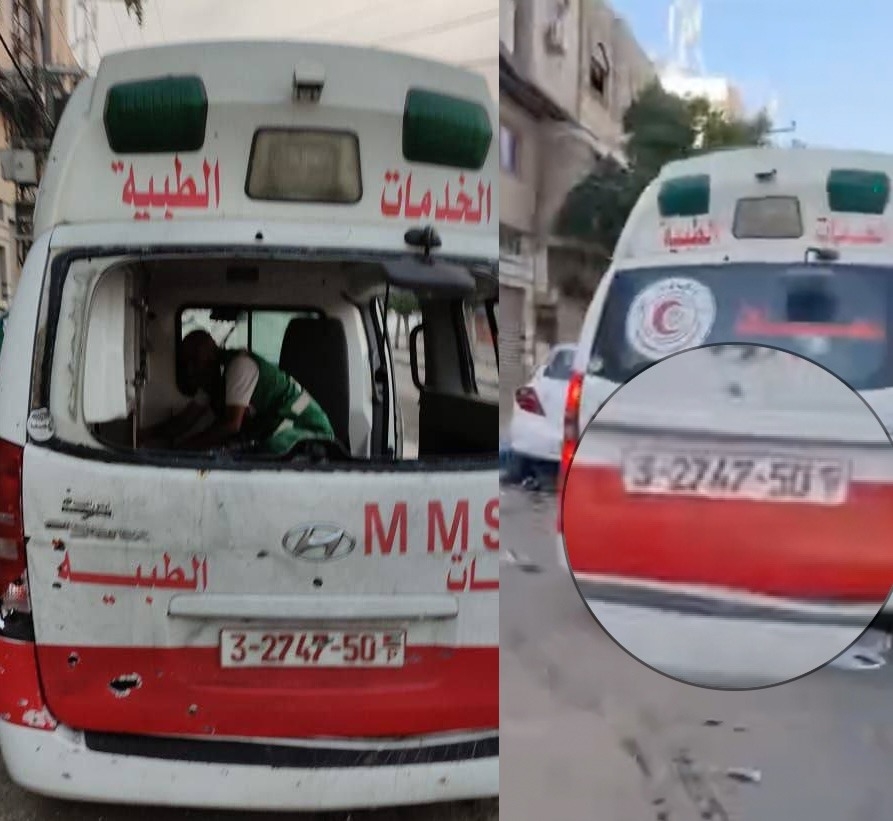
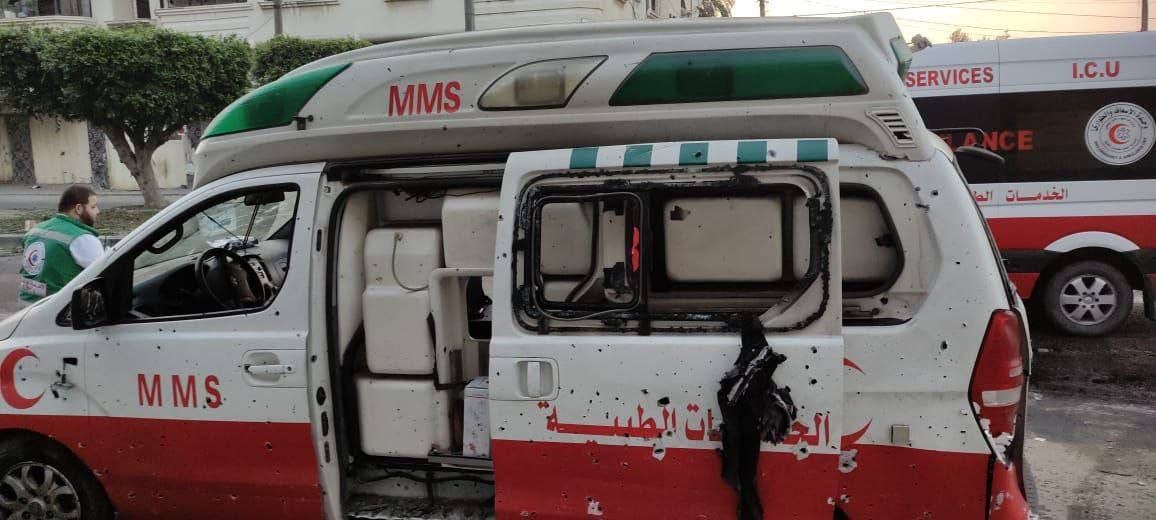
Photos from al-Quds News Network of the damaged ambulance. The ambulance license plate number is identical to the plate number that appeared in the video by the Palestinian Ministry of Health in Gaza.
Probable Ammunition
The video published by journalist Al-Zanoon on his Instagram account, taken a day after the incident, shows burned cars. At 0:09”, ammunition remnants can be seen on the ground, relatively similar to the rear propellers of mortar shells. They are small in size and may belong to 81 mm or 82 mm mortar shells.
Upon researching the use of these kinds of shells by both the Israeli military and armed Palestinian resistance factions, we found that the Israeli military is using shells known as the M43 Mortar Bomb, i.e. an 81 mm M43 mortar. The shape of the rear propeller left behind in the video of the attack site matches the rear propeller of mortar shells used by the Israeli army.
When this type of shell falls, fragmentation or fragment dispersion typically occurs at a 360-degree angle, the impact of which can be seen in videos of the bombed cars, as well as the dispersion of fragments on the ambulance wall.
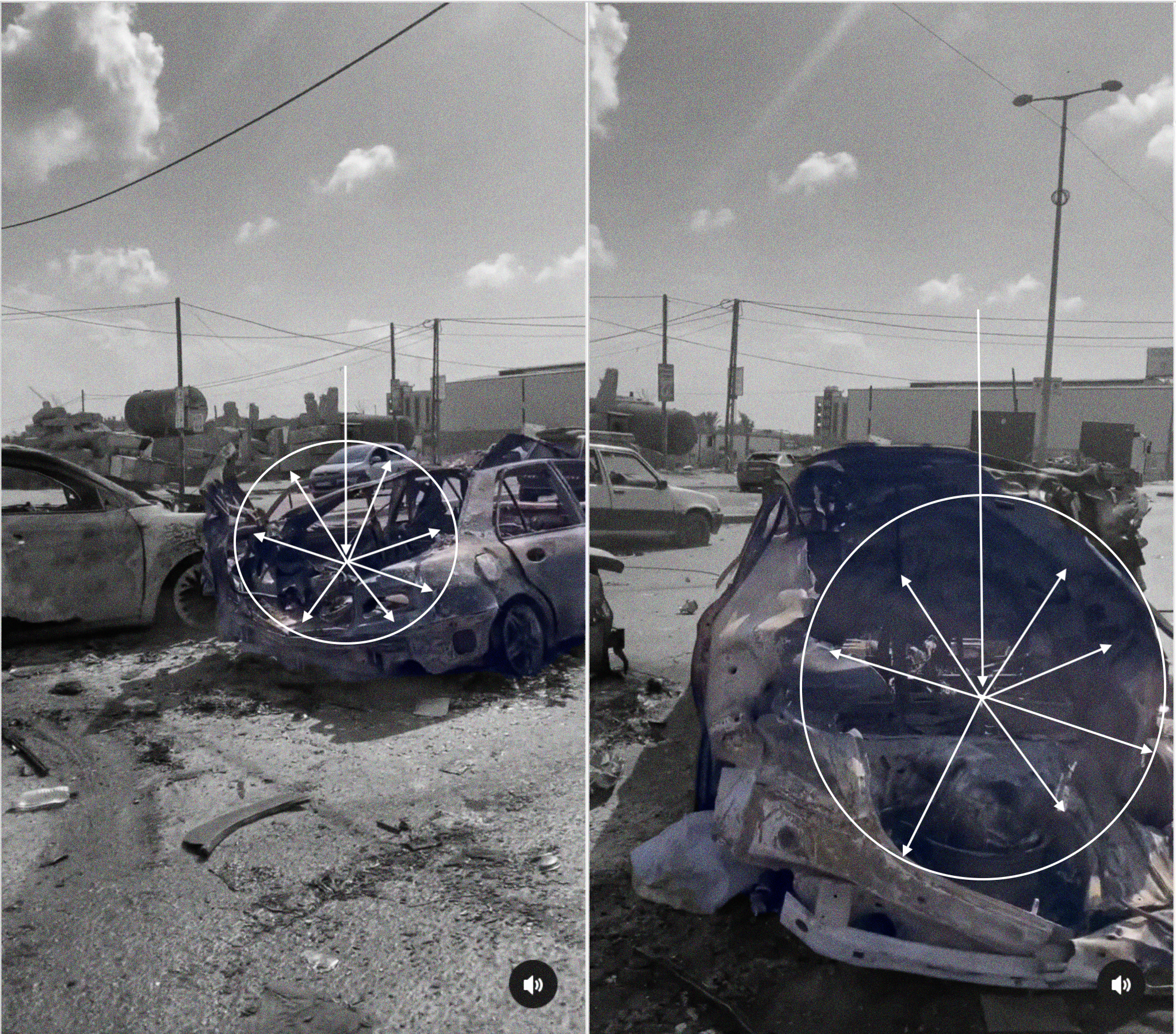
Screenshots from journalist Al-Zanoon’s video on Instagram, showing the shape of the projectile’s fall and its impact on the two cars. White circle and arrows: The shape of the fragment dispersion. Screenshots taken in October 2023.
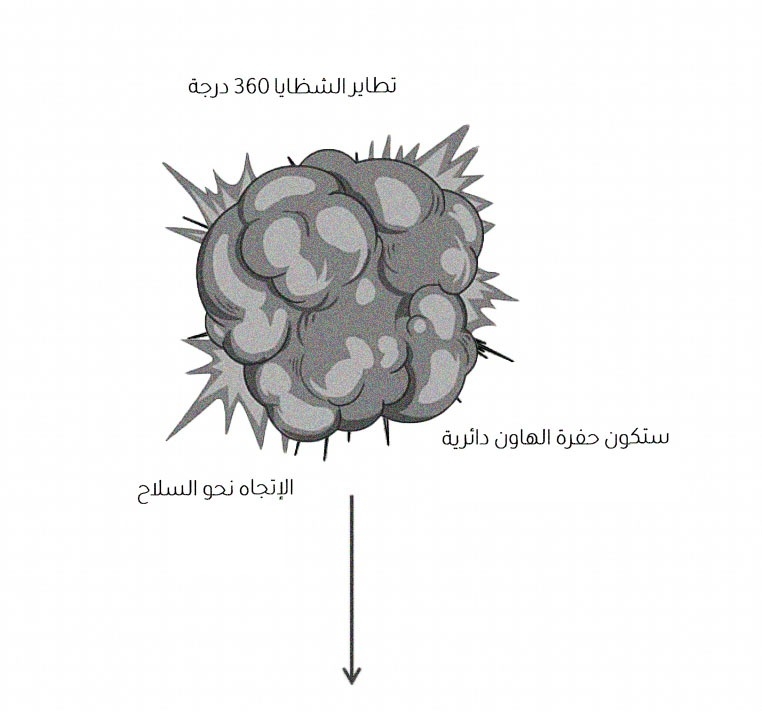
An illustration of the dispersion of fragments from mortar shells.
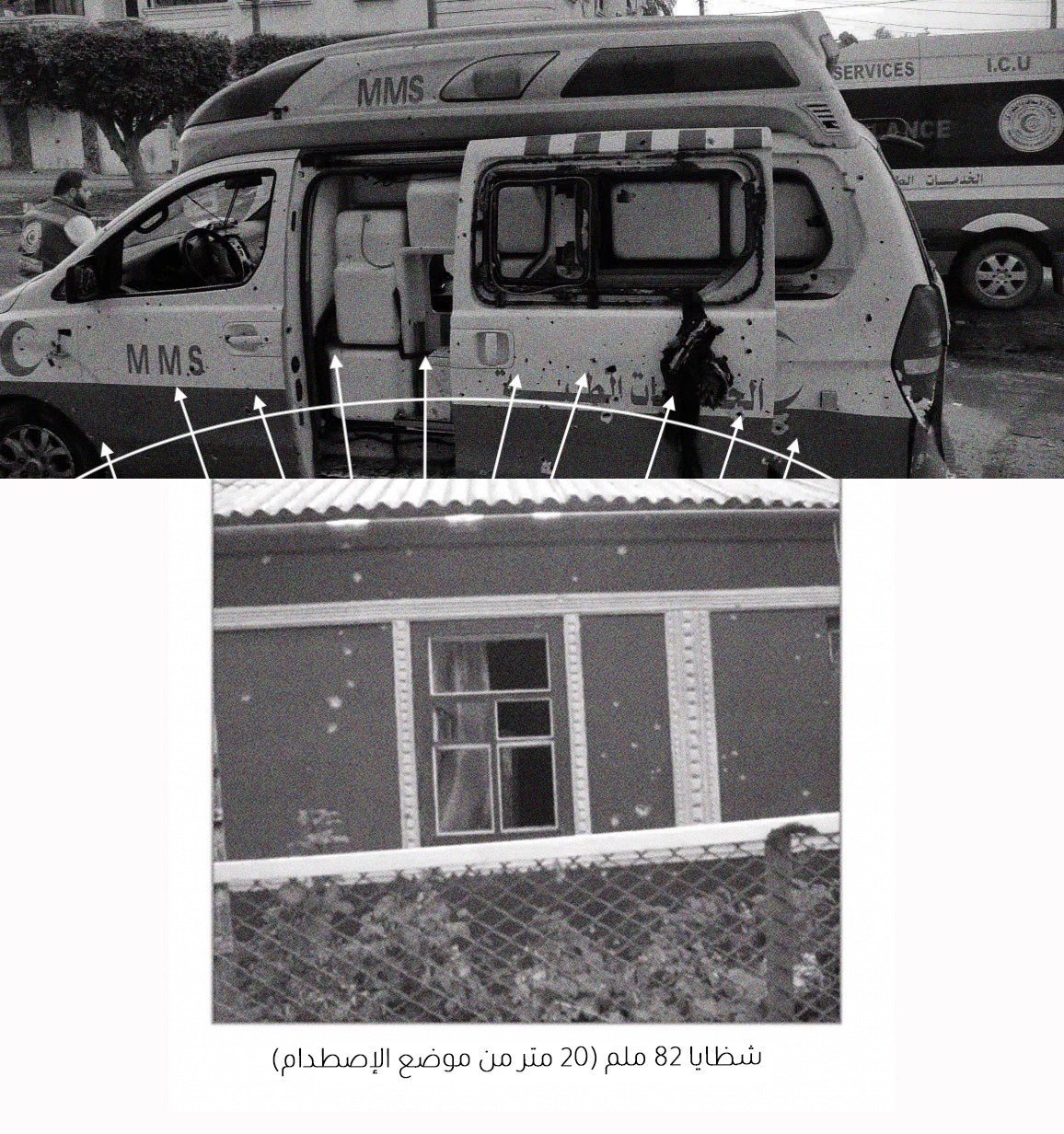
A photo of the ambulance from al-Quds News Network on Telegram. The photo shows the dispersion of mortar fragments onto the ambulance, which was within the mortar shell’s fragment dispersion range. The white semi-circle and arrows show the likely direction of fragmentation.
Our analysis circles back to the reason why the trailer of the truck carrying displaced people was impacted from the eastern side; it appeared to have bloodstains and some corpses on it, despite not being directly hit. This may be the result of shrapnel from a projectile that fell at a close range, unnoticed. The fragments of 81 mm mortar shells can typically reach as far as 20 meters.
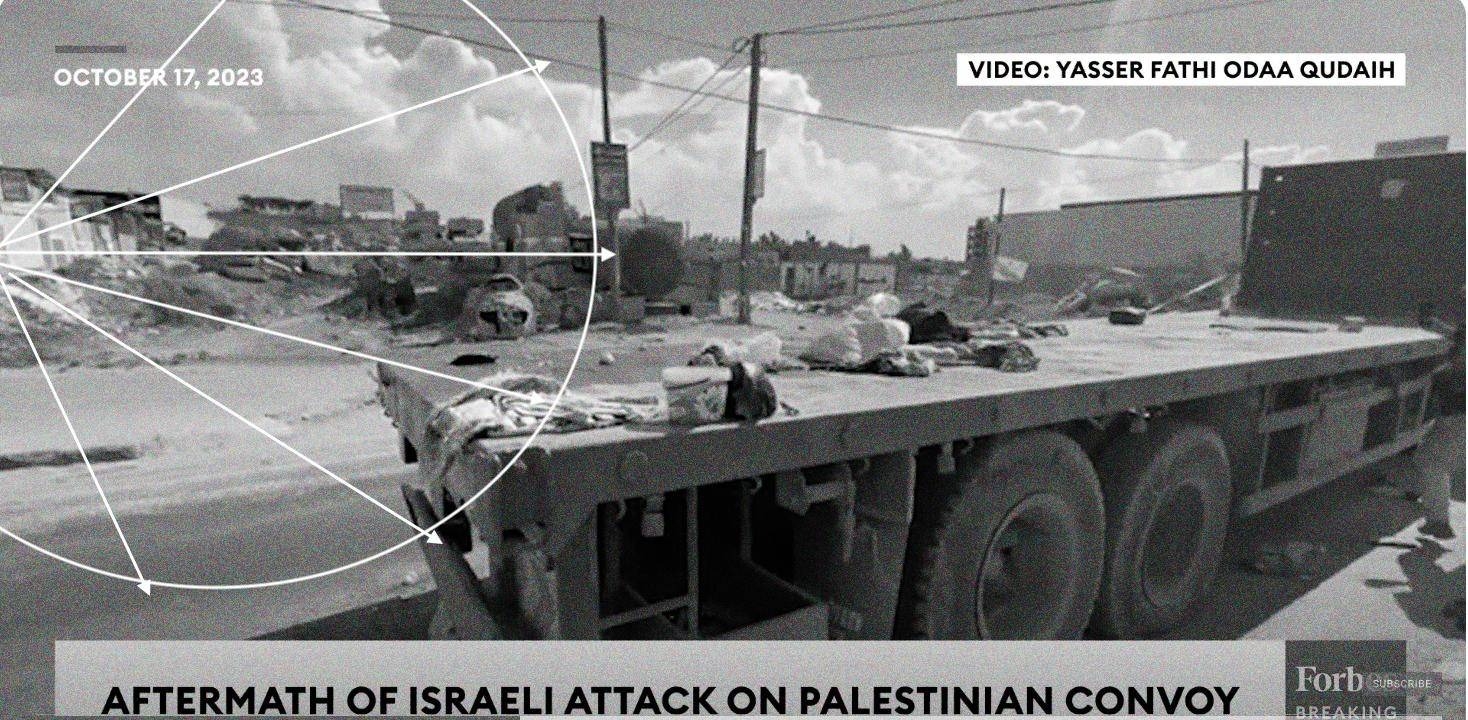
A screenshot from the Forbes Breaking News video showing bloodstains on the truck’s second trailer. The white circle and arrows indicate the possible extent and direction of mortar shell fragments. Screenshot taken in October 2023.
Facebook user Mohammed Sirhan wrote that he was at the site of the attack during the strike. He was taking a family from Gaza to the south in his taxi when several successive artillery shells targeted the cars and the displaced people passing through Salah al-Din Street. He added that he survived and ran away, leaving everything behind.
Mohammed’s account supports the possibility that the attack involved ground-to-surface bombing and not aerial bombardment. Additionally, in an interview with Sky News, the official spokesperson for the Israeli army denied that there were airstrikes on the area.
It is possible to determine the projectiles’ likely direction of arrival based on the size of the impact crater and the direction and locations of the projectiles’ fall: From the direction of the settlements northeast of Gaza City. The team searched for recent satellite images to determine the locations of the Israeli army in the northeastern settlements, but no helpful photos were found because they were encrypted on satellite imaging websites and included paid services at the time of writing the investigation.
It should be noted that this information is not an analysis produced by weapons experts, and therefore cannot be accepted as a final conclusion, and does not represent a claim by the authors of the investigation. It is merely an analysis of the data available so far.
While it is possible that the ammunition remnants may belong to any of the military forces within the possible range for firing this type of shell, this cannot be confirmed. The ammunition remnants are merely additional evidence that can be used in open-source investigations, and other explanations for their presence at the attack site must be considered.
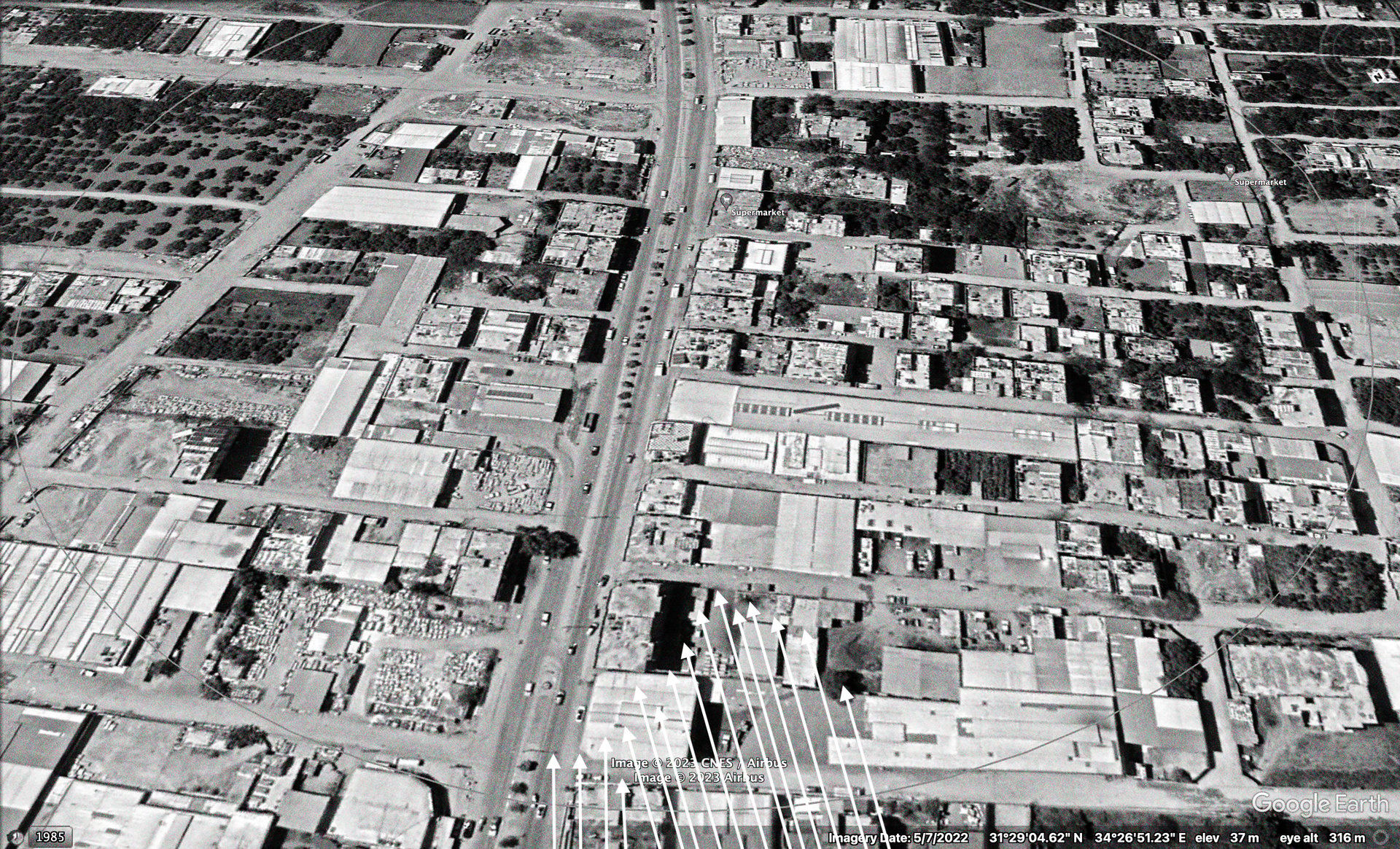
A screenshot from Google Earth Pro of the impacted location. White arrows show the likely direction of arrival of the projectiles. Images created in October 2023.
